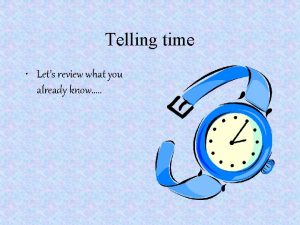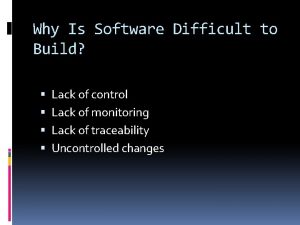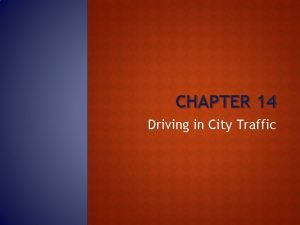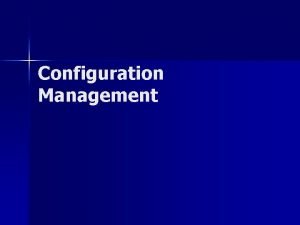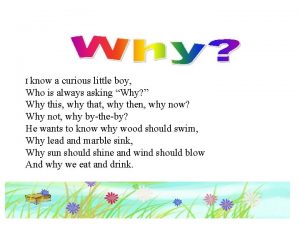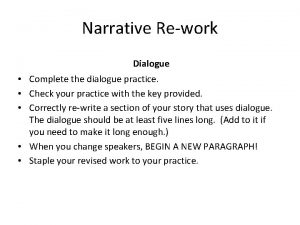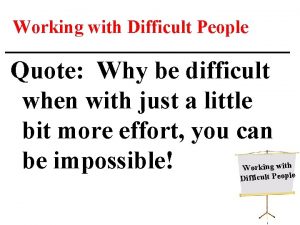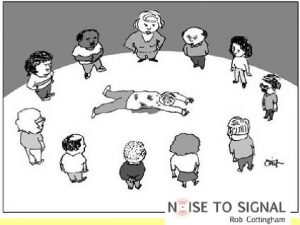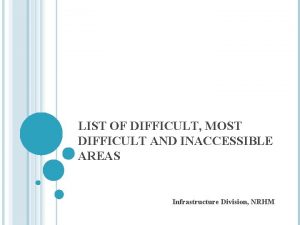Working with Difficult People Lets Know Why people




























- Slides: 28

Working with Difficult People

Let’s Know…… • Why people are difficult • Types of difficult behavior • Coping skills and techniques to help you communicate

Why Are People Difficult? • People feel – Rushed — not enough time – Insecure – Angry – And have some need or interest • Stressed!!!

Scenario 1

A Difficult Person Can Be. . . • • Hostile-Aggressive Know-It-All Yes-Person Whiner Never-Say-A-Word Indecisive Staller No-Person

Hostile Aggressive AKA “The Tank” • Bullies their way toward the results they want. • Belittles you in front of anyone. • Tries to convince you that you are doing a poor job when you are doing fine.

The Know-It-All • Controls people and events by dominating conversation with lengthy, imperious arguments. • Tries to find flaws in everything.

The Yes-Person • Answers “Yes” to every request without thinking about what is being promised. • Has deep-seated anxiety and a lot of resentment. • Seeks approval and avoids disapproval. • And even if all the promises can be kept, the Yes-Person no longer has a life!

The No-Person § Able to defeat big ideas with a single syllable § Deadly to morale

The Whiner • • Avoids taking responsibility. Wants sympathy. Has negative view of the world. It’s important for these people to get their opinions across. If you ignore them, they increase their protests.

The Never-Say-A-Word AKA “The Clam” • Timid, uncomfortable, and uncertain. • Wants to avoid conflict or hurting anyone. • Often feels angry because “the wrong decision” was made. • Some can’t relate authentically or speak honestly.

The Indecisive Staller • • Could be an overwhelmed “Yes-Person. ” Could be a procrastinator. Has reservations about the project. Doesn’t organize or prioritize work.

Difficult Person : Coping Plan 1. Assess the “Situation” 2. Stop wishing they were “different”! 3. Get distance between you and the difficult behavior 4. Formulate a plan for interrupting the interaction 5. Implement strategy 6. Monitor coping process 7. Modify or abandon plan, if necessary

Dealing with “The Tank” • If possible, get them to sit down. • Don’t back down. Let them vent. Don’t take it personally. Step away from the emotion. • Identify their issue–the facts of the matter. • Explain benefits of your point of view. Express your side in factual terms. • Allow aggressor to “save face. ”

Dealing with the Know-It-All • Know your facts. Be prepared. • Listen carefully and paraphrase the main points. • Use questions to raise issues. • If necessary, subordinate yourself to avoid static and commit yourself to building a more equal relationship in the future.

Dealing with the Yes-Person • • Work to get to the underlying issues. Tell how much you value them as people. Give them permission to say “No. ” Ask them to tell about any aspect of your product that is not as good as the best. • Listen to their humor -- hidden messages?

Dealing with the No-Person • • Work to get to the underlying issues. Find out the reason for disagreement Show the other side Show the benefits

Dealing with the Whiner • Don’t respond if they are blaming you. Don’t sympathize if they are at fault. • Make a list of all complaints from constant complainers before you discuss problem. • Make sure the facts are correct. • Make the Whiner propose solutions to fix the problem.

Dealing with “The Clam” • Try to draw them out about topics that are non-threatening. • Ask open-ended questions. • Wait for a response -- calmly. (Don’t fill the silence with your chatter. ) • If you get no response, comment on what’s happening. End your comment with an open -ended question.

Dealing with the Staller • Help document their goals and deadlines • Listen for indirect words, hesitations. • Ask them how you can help them achieve their goals. • Follow up on intermediate deadlines. Hold them to the deadlines. • Make it easy for them to tell you what is preventing their action.

Scenario 2

And What About You. . .

It’s All About ATTITUDE! • • • You are not going to change THEM. You will have to work with THEM. You are the one who can make the change. Make it happen! Be Positive

Principles of Human Behavior • All people are motivated. • You cannot motivate others ; you can provide the environment, skills, etc. • People do things for their reasons, not ours. • We are all different. . . Relationships should complement and complete each other.

Communication Is The Key. . . • Be clear about what is to be done. • Be clear about who is to do it. • Two parts to the message – Speaker has an image – Listener has an image – Are they the same?

Offline Coping Techniques • Don’t take their behavior or words personally. • Write down details of what annoys you. • Think about why it annoys you. • Which of your buttons does this person push? Why do you respond to them in the way you do?

Offline Coping Techniques (continued) • How would you like to respond? List the advantages of different responses. • Monitor yourself. • Give yourself positive feedback when you succeed in not getting caught up in the emotions of difficult people. • Be a happier person by handling all those you encounter with charm and grace.

Some Final Tips • Give support where needed. • Be an information broker. • Learn to keep it light. • Don’t forget to smile.
 Why why why why
Why why why why Lets see what you know
Lets see what you know Lets know each other
Lets know each other Lets see what you already know
Lets see what you already know Let's see what you already know
Let's see what you already know Lets see what you know
Lets see what you know Why is software difficult to build ?
Why is software difficult to build ? Beaumol
Beaumol Chapter 14 driving in city traffic
Chapter 14 driving in city traffic Why was italian unification difficult to achieve
Why was italian unification difficult to achieve What is software difficult to build
What is software difficult to build Rewrite the final six lines of the play in your own words.
Rewrite the final six lines of the play in your own words. How to deal with difficult people
How to deal with difficult people Communicating with difficult people
Communicating with difficult people Know history know self
Know history know self Dilan gorur
Dilan gorur I know who goes before me
I know who goes before me Working smart vs working hard
Working smart vs working hard Cold working
Cold working Hot working and cold working difference
Hot working and cold working difference Differentiate between hot working and cold working
Differentiate between hot working and cold working Pembentukan logam
Pembentukan logam Don't ask why why why
Don't ask why why why Health triangle
Health triangle Structure of merchant of venice
Structure of merchant of venice Curious little boy
Curious little boy Hooray cheered gilda. does that mean we can stay
Hooray cheered gilda. does that mean we can stay Market forms poultry
Market forms poultry Know you why
Know you why



